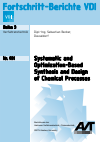Systematic and Optimization-Based Synthesis and Design of Chemical Processes
Zusammenfassung
In industrial practice, conceptual process design is typically conducted by repetitive simulation studies, which require detailed design specifications in an early design phase. Guided by heuristics, these iterative solution procedures result in high manual effort and, in addition, no guarantee concerning the quality of the solution can be given. Optimization-based design methods provide a tremendous potential to accelerate and improve conceptual process design. For this purpose, a synthesis framework for the optimization-based design of chemical processes is presented in this thesis. Powerful shortcut and rigorous evaluation methods for reaction and distillation are presented. These methods are computationally efficient in order to allow an optimization-based design of large-scale chemical processes. Various industrial case studies illustrate the application of the novel approaches and highlight their benefits.
...
Schlagworte
- Kapitel Ausklappen | EinklappenSeiten
- I–XIV
- 1–10 1 Introduction 1–10
- 1.1 Conceptual design of chemical processes
- 1.1.1 Design methods for reactor networks
- 1.1.2 Design methods for distillation-based separation systems
- 1.1.3 Design methods for reaction-separation processes
- 1.2 Aim and structure of this thesis
- 1.3 Previous publication of results
- 11–54 2 A unifying framework for conceptual process design 11–54
- 2.1 Variant generation
- 2.2 Optimization with shortcut models
- 2.2.1 Reactor shortcut
- 2.2.2 Separation shortcut
- 2.2.3 Solution procedure
- 2.3 Optimization with rigorous models
- 2.3.1 Multi-tube differential sidestream reactor
- 2.3.2 Continuous stirred-tank reactor
- 2.3.3 Simple distillation column
- 2.3.4 Reactive distillation column
- 2.3.5 Extractive distillation column
- 2.3.6 Vapor recompression column
- 2.3.7 Solution procedure
- 2.4 Illustrative example: ETBE synthesis
- 2.4.1 Variant generation
- 2.4.2 Optimization with shortcut models
- 2.4.3 Revision of the process variants
- 2.4.4 Optimization of a process superstructure with shortcut models
- 2.4.5 Optimization with rigorous models
- 2.5 Illustrative example: Allyl chloride production
- 2.5.1 Variant generation
- 2.5.2 Optimization with shortcut models
- 2.5.3 Revision of the process variant
- 2.5.4 Optimization with rigorous models
- 2.6 Conclusions
- 55–62 3 Systematic variant generation for catalytic processes 55–62
- 3.1 Batch vs. continuous
- 3.2 Input/output structure
- 3.3 Recycle structure
- 3.4 Model-based kinetic investigation
- 3.5 Separation system
- 3.6 Conclusions
- 63–94 4 Systematic design of a butadiene telomerization process 63–94
- 4.1 Variant generation
- 4.1.1 Batch vs. continuous
- 4.1.2 Input/output structure
- 4.1.3 Recycle structure
- 4.1.4 Model-based kinetic investigation
- 4.1.5 Separation system
- 4.2 Optimization with shortcut models
- 4.3 Optimization with rigorous models
- 4.4 Pilot plant experiments
- 4.5 Conclusions
- 95–98 5 Conclusions and final thoughts 95–98
- 5.1 Open research topics
- 99–114 Bibliography 99–114


